
By Angelo Randaci, Earth’s Ally Horticulturist
Angelo’s passion for plants has led him to explore many areas of horticulture including research, grounds management, technical training, design and nursery management.
Long ago, enchanted gardens were spoken of as places where magic happened. These stories always entailed some type of coming of age or a facing of inner demons theme. The mystery of the place was its ability to be time out of time, about the world beyond the world, the one nature creates. All earthly occasions were celebrated in the garden.
Each year on the summer solstice, the veils between the world of mortals and enlightened beings would thin enough for charms and incantations to beguile the mortals, alluring them into a state of trance or hypnotic seduction. Enticed by the beauty and mesmerized by the power of the garden, its inhabitants were captivated by the ability to reshape their future with song, celebration, and ceremony. As the enchanted made their way through the magical understory to the sacred spot prepared for their service, nature played tricks on each participant enticing them into giving up those things that held them back from the life of their dreams. By the time they arrived at the circle of enrapture they had given up all their old habits and personal foibles without struggle or regret.
Enchanted gardens were written about as otherworldly places, like heaven on earth. Enclosed by towering walls where vining flowers climbed to the top for escape, they could remain undisturbed by the mundane outside of the enclosure. Supernatural walls soaked in magic powers of transformation held the secrets of long life, great health, and improving fortunes. This was the place where dreams would come true.
The gardens were filled with medicinal herbs, rare flowers arriving from far-off places, and enough food to fill the households’ bellies for the entire winter months. Steeped in colors, fragrances, and textures the alluring flowers and fruits captivated the imagination of the young and old alike. With pathways ambling beneath soaring trees, one got lost for hours while meandering down trails sprinkled with dappled sunlight illuminating the way forward.
Enchanted gardens of old were bursting with fantasy and folklore. Used as a place to find one’s ancestors or communicate with the fae of lore, they offered the hope of a carefree life of natural beauty and easy dreaming.
My own experience with gardens enchanted by the world of magic fireflies and buzzing bees began so far back that I can’t imagine what my age would have been. It was the first spring I can remember realizing that the world was a place outside of myself ripe for exploring. As a young child, I was surrounded by gardens created at the hands of my Sicilian father. He grew every flower he could find and every vegetable he could think of. Hour after hour I roamed the pathways and hidden spaces of that transcendent place. The garden was my first teacher and she guided me through the bare essence of what life was about.
In the garden, there is complete harmony. That was my first lesson. If harmony seemed out of balance, nature would see to it to bring it back into equilibrium. That was my second.
It was in the hidden nooks of the rose garden I learned that time passes and things move on, and with each passing season life comes and goes. When one season appeared to be over. it was actually just presenting the other side of its very nature. I learned that work and respite went hand in hand. Hours would pass without notice in that enchanted place. When in the garden time passed by in waves of experiences; ones that have lasted a lifetime.
Enchanted gardens are whimsical spaces used to evoke a sense of magic and wonder. A mix of natural elements, the garden gnomes and fairy folk live among gazing balls, unicorns, wind chimes, spinners, and kindness rocks. You can transform any garden into a magical paradise, whether full-scale or in miniature.
Secret Rooms in Enchanted Gardens
When designing a secret garden room, a well-defined entryway is an essential feature. The entryway is often narrow and hidden behind a gate or just beyond an archway. It hints at the magic to come. The entrance blocks the view of the garden creating a sense of mystery about what lies beyond.
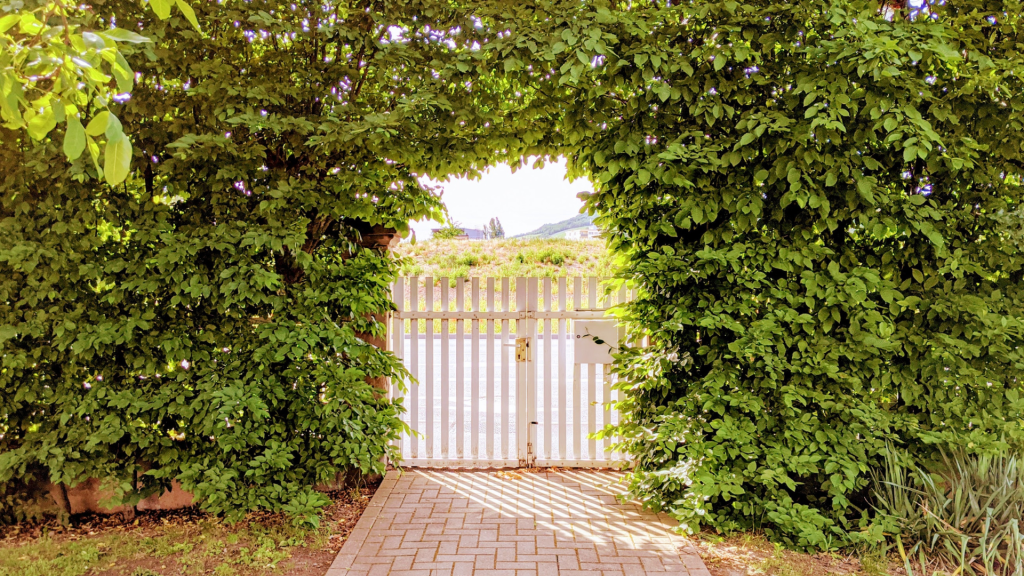
To create a well-defined secret space, surround your garden with fences or evergreen hedges with trees in combinations to create a layered planting. Add borders filled with flowers in consecutive bloom along with garden art in front of the fence or hedge. Design your pathways to be curved so one never knows what lies at the next turn or behind an upcoming hedge. This creates curiosity and mystery and entices your garden guest to look beyond the known to discover whatever comes next.
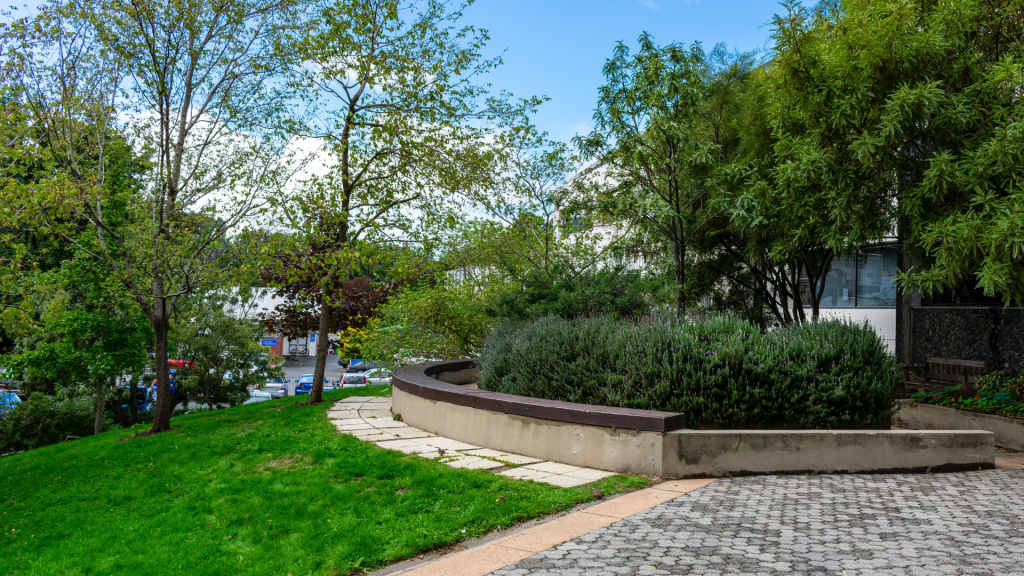
Add a final destination at the end or crosswalk of your design. It could be a simple table and chairs to enjoy a private meal, a seating area among the plantings for quiet contemplation, or a hammock for a summer siesta. Be sure to add focal points like a statue or water feature, a bird bath, or a metal sculpture.
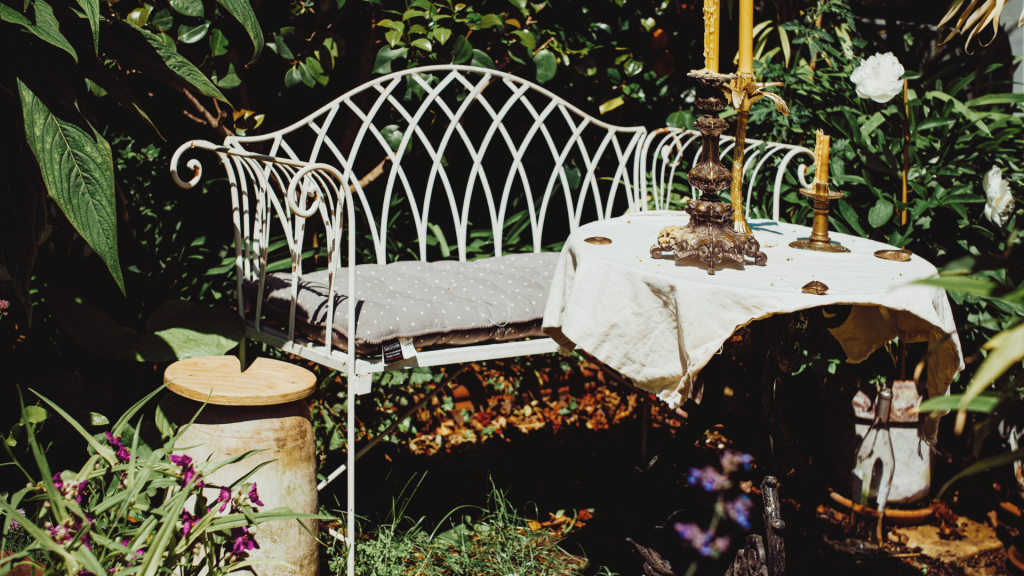
Secret garden rooms can also be fairy garden homes. Children love fairy gardens and secret spaces where they can hide and find the magic of their imagination. It gives children time to think, to contemplate, to imagine, and make believe.
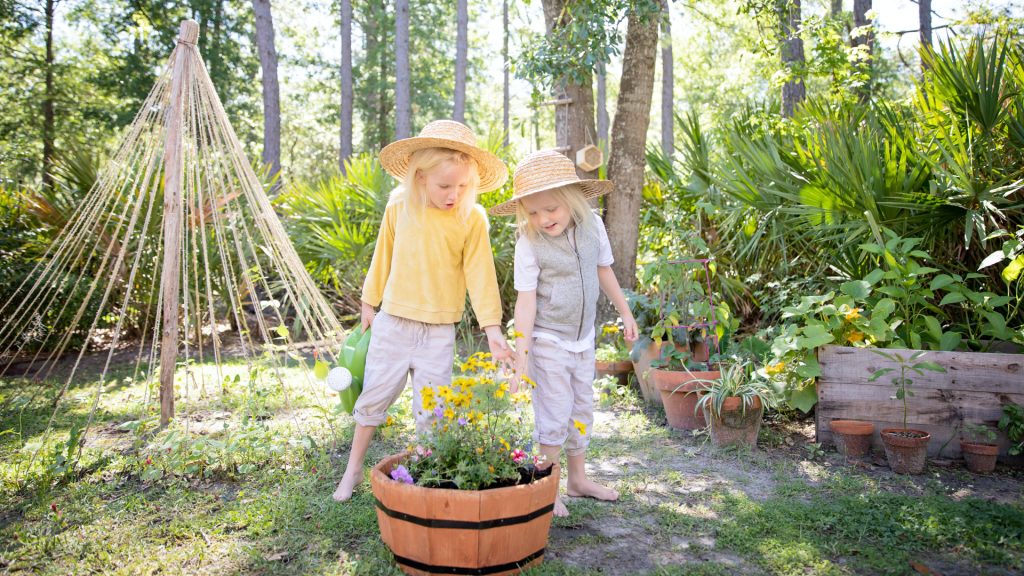
Selecting plants for your garden is a treat in itself. Your palate is yours to create. You can have a mixture of trees, shrubs, vines, perennials, annuals, edible flower plots, fruit trees, veggie beds, butterfly plants, pollinator beds, sun gardens, shade gardens, water gardens, any or all these areas decorated with whimsical adornments like giant flower pots, urns, birdbaths, mushrooms, statues, fountains, wind chimes, gazing globes, lanterns, and ominous outdoor lighting. All these are elements that add whimsy and charm to the enchanted garden.
Keep your garden plants healthy with Bee Safe and pet-friendly pesticides. Earth’s Ally 3-in-1 Plant Spray kills and repels mites and soft-bodied insects in addition to fighting common plant diseases.
Related: Keep It Cool with Shade Gardens
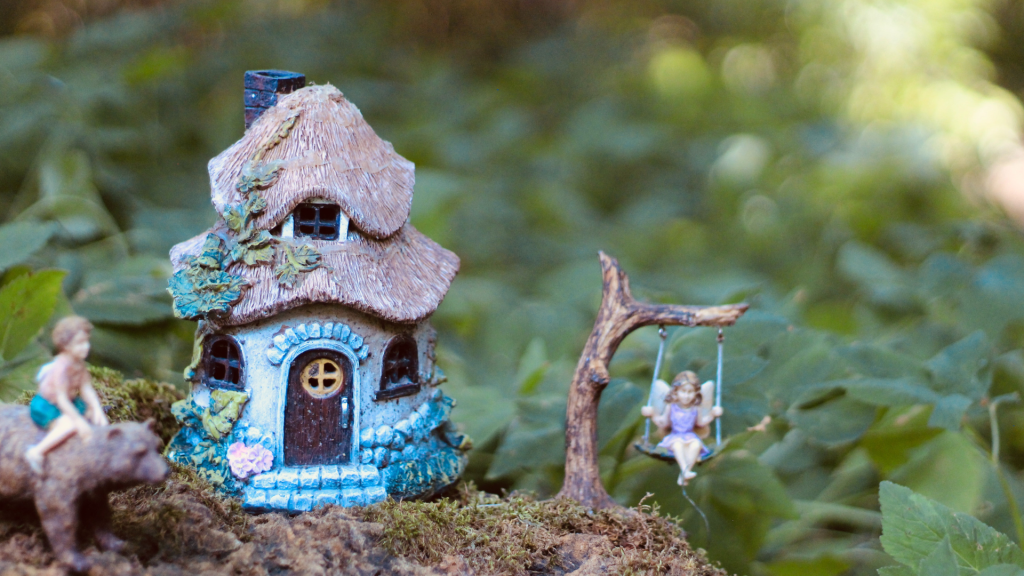
Scented shrubs such as lilac (Syringa), Summersweet (Clethra alnifolia), Sweetspire (Itea virginica), Koreanspice Viburnum (Viburnum carlesii), and roses delight the senses with both scent and color. Add the heavenly scent of lilies, carnations, and lavender along with colorful annuals to the mix. Climbing plants like honeysuckle, jasmine, clematis, and wisteria capture the imagination as they twist around a trellis or other structure. As you move into the shade, add vivid color with bleeding hearts, ferns, astilbes, and columbines.
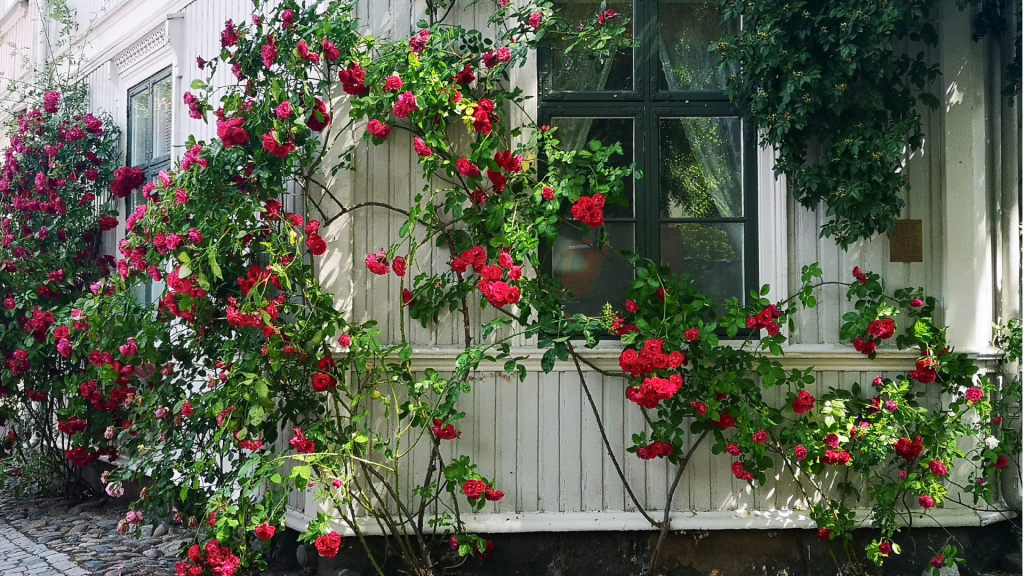
Whimsical Decorations and Artful Touches for Your Enchanted Gardens
Gazing globes have a long history dating back to the 13th century. They are believed to bring prosperity, health, good fortune, and protection from evil spirits to the garden keeper. With so many colors and styles, gazing globes add a mystical dimension to any garden setting. Tuck them among the flowers to add color and interest or place them on a stand to add height and a focal point. Group several together or hang them on trees along with uplighting for nighttime viewing. Miniature gazing balls are perfect decorations in fairy gardens.
And remember to add the element of sound to your enchanted garden, with soothing, melodious sounds of wind chimes, gongs, bells, and clappers. Since they don’t require batteries, extension cords, or artificial power, they can be placed anywhere. A gentle breeze is all that is needed to fill your garden space with music.

Fountains add the delicate sounds of flowing water creating a soothing atmosphere. There are a number of different ways you can incorporate water into your design. A sheet of running water flowing down the surface of an urn, bubbling water in a basin, or cascading water spilling over rocks awaken the senses to the magical energy of water.
A visit to your local salvage yard may reveal many treasures: beautiful pottery, statues, ornaments, garden spinners, and figurines. Look for weathered stone ornaments such as bird baths, urns, planters or gargoyles, dragons, and fairy figurines.
Related: How to Build a DIY Bee House
Add kindness rocks to your beds. This is a great project for both kids and adults. Each rock is transfigured with a loving message and painted with any pattern or color you choose. When finished, place them anywhere in the garden to convey your kindness and hope for all that enter your secret enchanted garden.

Garden gnomes are also a wonderful addition to any design. Gnomes date back to the early 1800s. In folklore, they were thought to provide protection for buried treasure and precious minerals in the ground. Today they are believed to bring good luck to the garden. While the first ones were made of clay, nowadays garden gnomes are available in a wide variety of materials, colors, and sizes for any enchanted scene. Place them anywhere you like; near an entrance to welcome visitors, lurking in the bushes, or simply under a tree.

If you live in a small space without room for a full garden, try creating miniature fairy gardens in containers. Fairy gardens capture the magic by utilizing elements on a tiny scale. Plant selection is based on textures, colors, and leaves to resemble the look of full-size trees, shrubs, and ground covers. Known to bring good luck and happiness, a fairy garden can be created in a bowl, flower pot, or any container with drainage holes. Containers should be at least 6 inches deep and wide enough to accommodate the items and plants you will be using. Choose a quality, well-draining potting soil to use as the base. Fill your container with soil making sure to leave a one-inch rim free of soil to collect water. Create pathways with broken clay pieces, pebbles, marbles, or stones.
Related: Delightfully Uncommon Types of Succulent Plants
Your selection of plants depends on where you will be placing your fairy garden. Will your garden be placed in full sun, partial sun, or shade? Once decided, choose miniature plants for your landscape for flower and foliage interest. A small bonsai tree fits well into the fairy garden scheme as it resembles a full-size shade tree. Some plants can also be pruned to look like trees. Look for plants in two or three-inch pots. Succulents work well in full sun and many will tolerate partial sun conditions. Other plants include ferns, baby tears, wooly thyme, and small-leaved ivies. Buy plants in 2- or 3-inch pots and keep them in their containers. Do not overcrowd your plantings so you have room for other accessories. Visit your local craft store or go online to find miniature items such as tiny houses, chairs, toadstools, pails, lanterns, and fairies.

Use popsicle sticks for fencing, twigs for ladders, and moss for added decorations. But more than anything, have fun in your garden whatever the size!
We’d love to hear how you’re using Earth’s Ally 3-in-1 Plant Spray. Share your experience and stay connected with the #EarthsAlly community on Facebook, Instagram, and Twitter for access to our latest blog posts, giveaways, and exclusive promotions.
